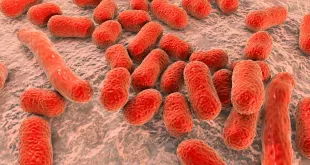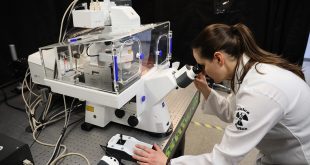By Jana Manolakos
There’s no sugarcoating it. Diabetes is growing at an alarming rate in Canada, afflicting one in three Canadians. It’s particularly worrisome for Canada’s First Nations and Inuit populations, where rates of diabetes on some reserves are three to five times higher than the general population.
In the face of this threat, two leading Canadian scientists and their teams believe that plants may hold some answers to managing the disease.
At the University of British Columbia, Stephen Withers, Director, Centre for High-Throughput Biology and Canada Research Chair in Chemical Biology, and his colleagues have devoted decades to uncovering a better way for diabetics to take life-saving drugs – and it all stems from a common garden flower.
A compound they discovered in the root bulbs of a plant known as Crocosmia ,or Monbretia, holds promise in alleviating bowel discomfort that arises when taking drugs to control blood glucose levels.
One class of drug commonly used with diabetics prevents or slows down gut enzymes like alpha-glucosidase from moving glucose into the bloodstream. As a result, other enzymes like undigested oligosaccharides pass further down the gut where they provide “fast food” for gut bacteria.
“These gut bacteria produce a lot of gas as a side product… so the patient tends to suffer from diarrhea and flatulence. As a consequence, they do not tend to take the drug,” explains Withers.
The team proposed that if they could develop selective inhibitors of the alpha amylase instead, it would prevent the starch from being digested. They expected it would greatly decrease the amount of glucose hitting the bloodstream and would not generate the “fast food” oligosaccharides that cause problems. In this way, they could have a drug that controls blood sugar but without the unpleasant side effects.
They spent almost 20 years working on understanding the enzyme and designing and synthesizing molecules as inhibitors. But none were practical.
“We then looked for alpha amylase inhibitors in nature and after screening 30,000 extracts of plants came up with the compound Montbretin A (MbA), which has exactly the properties we want. This compound comes from the corms (root bulbs) of a beautiful garden flower known as Crocosmia or Monbretia,” says Withers. Robots were key in helping sift through thousands of extracts.
The main challenges lay in identifying exactly how the plant makes this compound and developing a cost-effective purification strategy to draw out large quantities of it. Large-scale purification equipment was used to obtain the quantities needed for animal studies. X-ray equipment and computers were also used to understand how MbA inhibits the alpha amylase.
Withers explains, “We now have a reasonable protocol, but it is still not clear that we can grow and purify at a low enough cost to be economic.” The team engaged Jorge Bohlmann from UBC’s Department of Forest and Conservation Sciences and his postdoctoral fellow, Sandra Irmisch, in this process on lifting the genes responsible into an organism, such as yeast, in order to create a factory for production of MbA by fermentation.
“We now know that the compound is safe and effective in rats, and on the basis of our data we have obtained permission to perform a clinical trial in humans to test its safety.” The team is confident that they will be moving to a Phase 1 trial given the rat data and the similarity of the molecule to others in the human diet. “That trial was put on hold due to the COVID-19 pandemic, but we hope to be able to start this soon,” adds Withers.
The work was funded for many years by the Canadian Institutes of Health Research (CIHR), with basic research funding and then a “Proof of Principle” commercialisation grant. More recently, the national research network GlycoNet funded work in both Bohlmann’s and Withers’ labs, as well as funding the animal studies and contributing funds towards the human clinical trial.
But taking it further to commercialization will require substantial investment, concludes Withers.
Working with Indigenous communities to harness the potency of plants in treating diabetes
In a vast area of sub-Arctic boreal forest, the 30,000 Cree of Eeyou Istchee, located in northern Quebec and along the eastern shores of James Bay, experienced a troublesome rise in diabetes over the last few decades. It’s a statistic reflected in many of Canada’s Indigenous populations.
It’s also an area of interest for Pierre Haddad, Executive Director of the Quebec Indigenous Health Research Network, and founder and president of Phytothera, a natural health products consultancy. The Network, which launched earlier this year, provides an important space for Indigenous communities, researchers and knowledge users to work together on health promotion and community-based participatory research and training.
Haddad, who recently retired from his post as professor of Pharmacology at the University of Montreal, is a leading expert on medicinal plants, functional foods and traditional medicinal plants for the treatment of diabetes. In collaboration with teams from the universities of Montréal, Ottawa and McGill, he has co-led several studies investigating ways to integrate traditional medicine with modern science to improve the health of the Cree of northern Quebec. The majority of these studies received financial support from the Canadian Institutes of Health Research, mostly through its Institute of Indigenous Peoples’ Health.
Haddad explains, “It is important to explore ways of dealing with diabetes that are in harmony with aboriginal peoples’ culture and lifestyle. Medicinal plants have been around for a long time and used for a variety of ailments and conditions. They are a wealth to be recognized and valued.”
The research team, including experts from McGill University, University of Ottawa, Uschiniichisuu Myupimaatisiiun, Cree Board of Health and Social Services of James Bay and the Montreal Botanical Garden, relied on ethnobotany to characterize plants with the highest antidiabetic potential, and relate these to Indigenous traditional medicine and treatments. They worked closely with a large portion of the Cree communities of Eeyou Istchee, a territory that covers over 300,000 km2.
For the project, plants were screened for glucose-lowering properties, toxicity, drug interactions and complexity, through a series of in vitro cell-based and cell-free bioassays to isolate pure active compounds. Species that showed promising biological activities were studied in greater detail to understand their cellular and molecular activities, identify their active phytochemical principles, and determine their safety and efficacy through in vivo animal studies (Tier 2).
The most active plant species were tested in Tier 3 clinical studies with Cree diabetics taking traditional medicine alongside conventional drug therapy.
Concurrently, the Cree Elders and healers identified traditional medicinal plants the community used in treating diabetes.
The results revealed that over 60 per cent of the plants showed significant antidiabetic potential and were the same as those prioritized by the Cree Elders and healers. “It honoured not only the great wisdom and knowledge of Indigenous healers, but also showed the value of cross-cultural collaboration in health research,” notes Haddad.
All aspects of the research program were community-based such that Elders and other community representatives were directly consulted and involved at every level. “A major focus was thus placed on reciprocal knowledge translation,” explains Haddad. Finally, networking with other aboriginal initiatives across Canada and training of young Cree in traditional medicine was an important component of the project. However, the researchers found themselves short on time and resources.
“The success of this research depended heavily on the relationships between researchers and participating Indigenous communities,” explains Haddad. To gain successful results, it was vital to earn the trust of communities involved. “Anxieties from the Cree communities typically concerned ownership and misuse of traditional knowledge alongside fears that the publication of results would lead to the over-exploitation of plant resources and potential misuse of the medicines,” he adds.
A legally binding research agreement protected the collected traditional knowledge. The consent of Elders was obtained at all stages of the project and a protocol was set for the pre-publication review of documents by Cree Elders. “The hope is that these documents can serve as an adaptable template for future research.”
Canada is rich in medicinal plants
The Cree, along with other Indigenous groups, have had success using medicinal plants to treat illnesses and diseases for centuries, according to Health Canada. The aboriginal peoples of Eastern Canada alone have recorded 400 species of medicinal plants with over 2,000 uses listed, many including diabetes-related conditions.
 BioLab Business Magazine Together, we reach farther into the Canadian Science community
BioLab Business Magazine Together, we reach farther into the Canadian Science community





